Address any questions or comments regarding this newsletter to the individual authors listed after each article or to its editors, Nathan Johanning, 618-939-3434, njohann@illinois.edu or Bronwyn Aly 618-695-6060, baly@illinois.edu. The Illinois Fruit and Vegetable News is available on the web at: http://ipm.illinois.edu/ifvn/. To receive or be removed from email notification of new postings of this newsletter, contact Nathan Johanning or Bronwyn Aly at the phone numbers or email addresses above.
In This Issue:
Upcoming programs (listings for beginning and established growers)
News & Announcements (July Twilight Meeting Highlighting Cover Crop and No-till Management, New Home-To-Market Act To Grow Small Food Businesses and Make Illinois More Delicious)
Regional Reports (St. Louis metro east, southwestern Illinois (Waterloo), southern Illinois (Murphysboro), Dixon Springs)
Fruit & Vegetable Production & Pest Management (Renewed Reflex Label on Pumpkins and Winter and Summer Squash and Pumpkin Weed Management Highlights, Pumpkin Insect Management, Apple and Peach Insect Management)
Upcoming programs
See the University of Illinois Extension Local Food Systems and Small Farms Team’s website at:
http://web.extension.illinois.edu/smallfarm/ and the calendar of events at http://web.extension.illinois.edu/units/calendar.cfm?UnitID=629.
- 2021 Southern Illinois Summer Twilight Meeting Series, monthly evening meetings May-August at 6 p.m. After a year off, plans are underway to host IN-PERSON twilight meetings across southern Illinois during the 2021 growing season. For more information visit https://extension.illinois.edu/news-releases/2021-southern-illinois-summer-twilight-series or to register online directly, visit go.illinois.edu/2021TwilightSeries
- July 12, 2021 Baebler Educational Farm, Waterloo, IL – no-till tomato & pepper production
- August 16, 2021 Bauman Family Farm, Vienna, IL – regenerative grazing in cattle production
- Purdue Small Farm Education Field Day and Webinar Series, Purdue Student Farm July 29, 2021. Webinar Series, August 2-13, 2021, live online education. This program covers a wide range of production topics. For the listing of topics and registration visit https://www.purdue.edu/hla/sites/studentfarm/events/
News & Announcements
July Twilight Meeting Highlighting Cover Crop and No-till Management
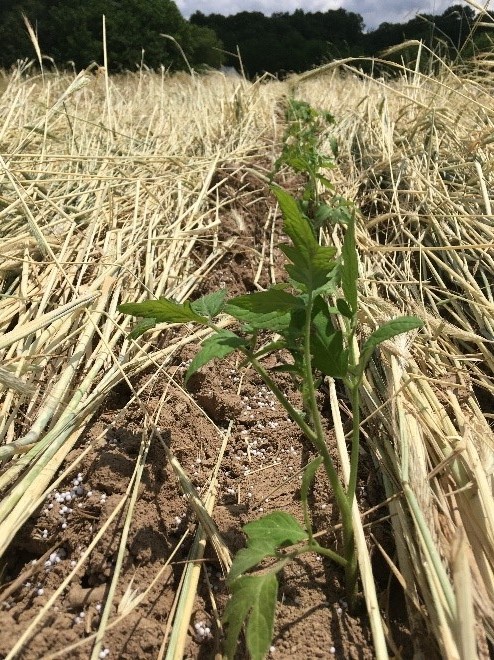
No-till tomatoes with a cereal rye cover crop. Photo: N. Johanning
For anyone interested in learning more about cover crop management in vegetable crops make sure to mark your calendars for our July Southern Illinois Summer Twilight Meeting on Monday, July 12, 2021 at 6 PM at the Baebler Educational Farm (4022 JJ Rd.) in Waterloo, IL. We are going to be highlighting the research I have been sharing through the newsletter over the last year or two. Some of the topics of discussion will include:
- Cover crop management for bareground and plasticulture systems
- No-till crop management
- No-till equipment demonstrations
- Crop and weed management practices
There are many opportunities to benefit from cover crops no matter what production system you are in! Our primary research is on tomatoes and peppers, however, we also have some demonstration plots of no-till green beans and sweet corn. To register for this meeting visit go.illinois.edu/2021TwilightSeries. Feel free to contact me if you have any questions!
Nathan Johanning (618-939-3434; njohann@illinois.edu)
New Home-To-Market Act To Grow Small Food Businesses And Make Illinois More Delicious Legislation awaits Governor Pritzker's Signature

The newly passed Home-to-Market Act gives small farmers like Derek and Libby Ervin of Glacier’s End Farm in rural Southern Illinois an opportunity to reach new customers by selling their unique jams, jellies, syrups, shrubs and hot sauces online.
Springfield, IL— New legislation passed by the General Assembly will bring more jams, jellies, pickles, baked goods, and artisan products to Illinois. The Home-to-Market Act SB2007, sponsored by Rep. Will Guzzardi and Sen. Dave Koehler, creates smart new regulations for cottage food operations, enabling them to reach new customers, while giving the public greater access to unique Illinois products.
“Illinois has an estimated 500 cottage food businesses, most of them small farms and women-owned businesses,” says Molly Gleason, spokesperson for Illinois Stewardship Alliance and lead organizer for the bill. “Improved cottage food regulations will not only support these existing businesses, but potentially help grow thousands more, at the same time providing shoppers with more opportunities to buy local and support their neighbors. It’s a big win for the local food economy in Illinois and one step closer to our goal of helping Illinois farmers feed Illinois.”
Cottage food laws exist in varying degrees in every state of the nation to provide farms and food entrepreneurs an avenue to produce and sell certain low-risk products from a home kitchen without the need for a costly commercial kitchen or storefront.
In Illinois, the current law limits sales of cottage foods to seasonal farmers markets, with few exceptions. Illinois is one of just three states in the nation with this restriction, which prevents cottage food operations from reaching new customers and growing their businesses. The Home-to-Market Act addresses this issue by expanding sales avenues for cottage food producers to include direct-to-customer sales avenues such as fairs and festivals, home sales, pick-up, delivery, and shipping. Not included are sales to retailers or distributors.
“In October, in my neighborhood, we have a festival that’s called ‘Autumn Drive,’ and people from all over the Midwest come. I would like to be able to sell my jam and jelly during Autumn Drive to lots of people who are coming here. I also make a raspberry tea that I’d like to sell online. The Home-to-Market Act will allow me to do that,” says Ann Chaney, owner of Grace Farm Studios in Woodstock, Illinois where she raises primarily raspberries and sells a variety of cottage food products. “I’m in favor of this legislation because it makes farming more efficient and helps me sell all of my products to people who want to buy my products.”
“Our farmers don’t do this as a side-gig, they need this opportunity to have other outlets to sell their products,” says Liz DeRuntz, operations manager for the LEAF Food Cooperative in Southern Illinois, which organizes 18 small farmers to collectively market, package, and sell local products. Many of those farms produce cottage foods, ranging from dried noodles to herbal teas and hot sauces.
Both Chaney and DeRuntz are members of Illinois Stewardship Alliance’s Local Food Farmer Caucus, a group of 60 farmers that works to identify barriers to growing the local food economy, research solutions, and put forward legislation. The Caucus identified cottage food reform as their top priority for 2021. Members of the Caucus partnered with the Institute for Justice, Illinois Environmental Council, Chicago Food Policy Action Council, and Illinois Farm Bureau to draft the new legislation and champion the bill. The bill was also supported by a broad stakeholder group of cottage food producers and food justice organizations.
“The Act presents an important opportunity to support marginalized and low-income communities that are oftentimes unable to access the necessary assets and finances required to start a business,” says Kevin Erickson, manager of the urban ag program at Loyola University, and a member of the Alliance’s Local Food Farmer Caucus. Kevin notes that his work in the city opened his eyes to the inequities facing urban farmers, which drew him to the Alliance’s policy work. “As long as food can be produced safely, and we feel very confident that this bill outlines a very safe process that can be done successfully at home, the Home-to-Market Act will allow new businesses to start and existing ones to grow and flourish.”
The bill could not have come at a more crucial time for cottage food producers, many of which were negatively impacted by the pandemic. “I began selling my baked goods at an indoor farmers market during the winter of 2020, but when the pandemic hit, that venue closed and I no longer had a way to sell my products,” says Danielle Robinson of Dottie’s Kitchen.
Danielle was eventually able to start selling again at the Elk Grove Village Farmers Market in the summer, and even started purchasing some local ingredients, like zucchini for her zucchini bread. She is excited to see the new Act pass. “Being able to sell direct-to-consumer through a website will allow me to reach a wider audience and make my business more resilient during events like COVID-19, which disrupted farmers markets nationwide.”
- In addition to expanding sales avenues, the Home-to-Market Act:
- Adds a handful of new food safety provisions negotiated with public health stakeholders to insure public safety, including a written food safety plan for products like pickles and kimchi
- Approves buttercream icing for sale under cottage food law, freeing home-bakers to make cakes, cupcakes, and other high-demand baked goods that customers desire.
- Directs IDPH to work with a stakeholder group of public health associations and non-profit organizations to issue guidance on a standardized registration form, inspection form, and a home-self certification checklist that outlines procedures and equipment for a home-kitchen.
The Home-to-Market Act passed the House and Senate unanimously and now awaits the Governor’s signature. Once signed the bill will go into effect in January 1, 2022
For more information about the bill and how to support this effort, visit www.ilstewards.org/hometomarket
Contact:
Molly Gleason
Illinois Stewardship Alliance
Regional Reports
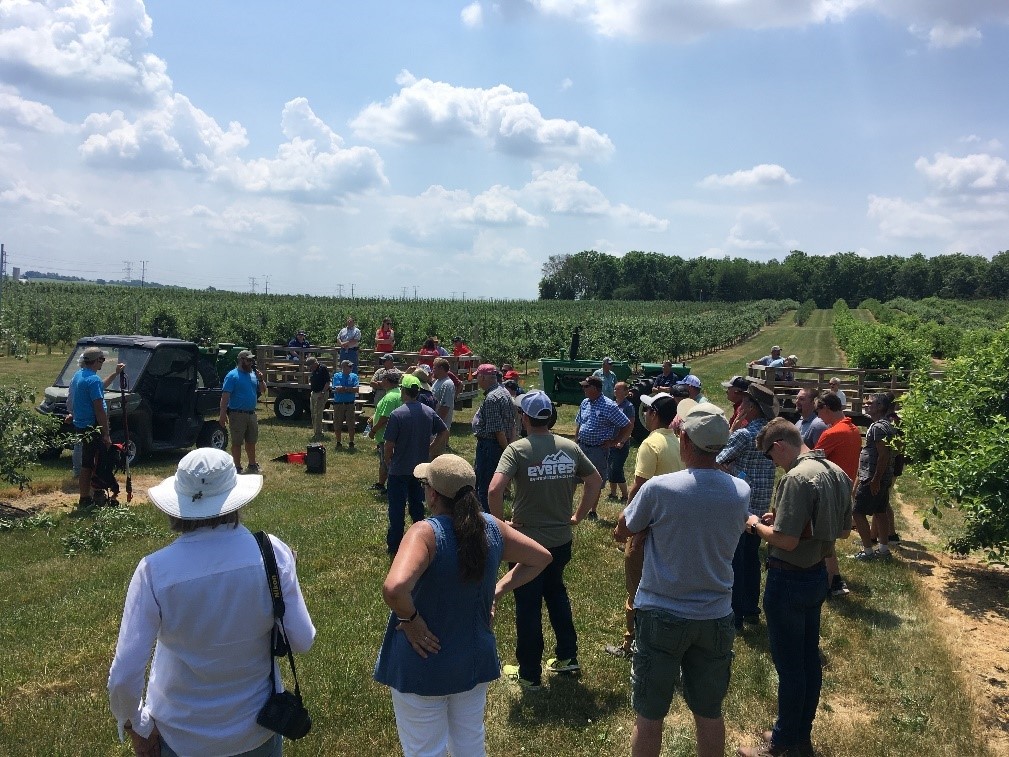
St. Louis metro east… A special thanks to Edwards Apple Orchard West for hosting the 2021 Illinois State Summer Hort Day. It was a great turnout and even though it was a hot one, the beautiful orchard, hospitality and face-to-face fellowship made it a perfect day!
2021 Illinois State Horticulture Society Summer Hort Day, held June 10th at Edwards Apple Orchard West in Winnebago. Photos: N. Johanning (top) E. Wahle (bottom)

Like many throughout the state reported at the meeting, the metro east could use some rain too, especially those to the southern portion of the region. Temperatures have been soaring well into the 90s, somewhat slowing you-pick business during the heat of the day. The heat is also prompting apple growers to start sunburn and moisture loss protection, using products like Raynox (Valent) and Vapor Gard (Miller). Peach season is almost upon us, maybe as early as next week, as well as possibly the start of Lodi apple…with the start of sweet corn not far behind. Strawberries have come to a close, but black raspberries and early blackberries like Natchez are coming into harvest. Local tomatoes, depending on type and production system, are in harvest or coming soon. The main take home is all the crops customers expect for 4th of July picnics are ahead or on schedule and should be plentiful. Crops for fall activities are in the planting stage as well, including Jack-o-lantern, pie pumpkins, sunflower and zinnia patches.
Elizabeth Wahle (618-344-4230; wahle@illinois.edu)
From southwestern Illinois (Waterloo)… We have been hot and dry until just the 6/21 after a front drop our humidity and temperatures. Prior to that we were in the 90s with lots of humidy. We will get a short break but the heat and humidity will be back by later this week. We are fairly dry down here, however, not nearly as dry as those of you were in the northern part of the state. We had about 0.4” early Monday morning (6/21), but other than that have only had about 0.2” of preciptation in the weeks prior. Some corn fields were rolled up in the heat due to the dry. I planted some no-till sweet corn and green beans and did some transplanting and where there was a residue and the soil had not been distrubed there was decent soil moisture. They are now starting to emerge, but would certainly appreciate some more moisture.

Tomato hornworm on tomato (left). No-till transplanting on research trials (top). Photos: N. Johanning (left) S. Rick (top)
In the last part of May and first week of June we got our cover crop trials planted with tomatoes and peppers at Waterloo and Urbana. All are looking good now 3-4 weeks later. We have had a significant explosion of tomato hornworms on both the tomatoes and peppers in the last week. At first glance I was suspicious of deer grazing, however, the dropping beneath the plant and a closer inspection found that hornworms were the culprit. We removed any we have found, but will probably spray soon to prevent damage from getting any worse. For recommendations on this or any other vegetable pest consult the Midwest Vegetable Production Guide .
Fortunately, only a few plants were severly affected however this could change quickly. Overall the trial is looking good and the tomatoes have already been tied twice.
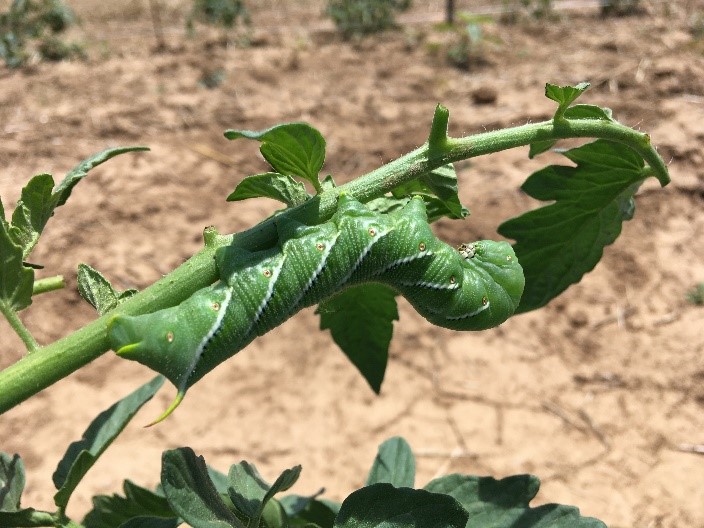
We are in the midst of blueberry and red and black raspberry harvest and the start of some of the early peaches. Some of the earliest sweet corn in tasseling and harvests of early-planted summer vegetable like green beans, cucumbers and summer squash. High tunnel tomatoes are starting to come in as well. My potatoes are past boom now and looking pretty good, however having been hilled and cultivated without a lot of rain since, they would appreciate some precipitation. Pumpkin planting is underway. I am hoping to transplant my pumpkins within the next week if everything cooperates. Please see my note later in this issue regarding our renewed label for Reflex in pumpkins and other weed management highlights!
I enjoyed seeing some of you at the State Horticulture field day and hope to see some of you at our July 12 Twilight Meeting!
Nathan Johanning (618-939-3434; njohann@illinois.edu)
From southern Illinois (Murphysboro)…Here in Jackson County we are officially in full swing. The first heirloom tomatoes have been harvested out of the high tunnel, the green bean variety trial has been planted (twice), and the fertility trial tomatoes are going strong. The blueberries and blackberries are starting to ripen, and the asparagus is fully ferned out and resting for the season.
The high tunnel is currently at full capacity and we have started harvesting tomatoes, peppers, and cut flowers. The shade cloth was placed on the high tunnel at the end of May. Pumpkins were seeded into cell trays on June 10th, these will be transplanted into the field in early July.
Out in the field the green beans were seeded onto black plastic rows from the 2020 growing season. The plants that were transplanted as well was those that were direct seeded in the first round (May 28th) are off to a good start. However, beans that were seeded into the plastic on June 2nd were not fully germinated by the time we started to see high temperatures. Many of the plants were burned off at the cotyledons as a result of touching the black plastic. A duplicate green bean trial has been planted in a strip tilled area.
The tomato fertility trial was fertigated for the first time on June 11th. This year there are 11 treatments with different potassium rates, fertilizer formulations, and timings. We are starting to see lots of green fruits on the plants and they have been tied several times. Due to the frequent rain at the beginning of the month I have been sticking to pretty tight fungicide spray schedule to avoid disease issues. As always I wish everyone a happy and safe 2021 growing season!

Tomato fertility trial being grown at the Jackson Co Extension office. Photo by K. Bell.
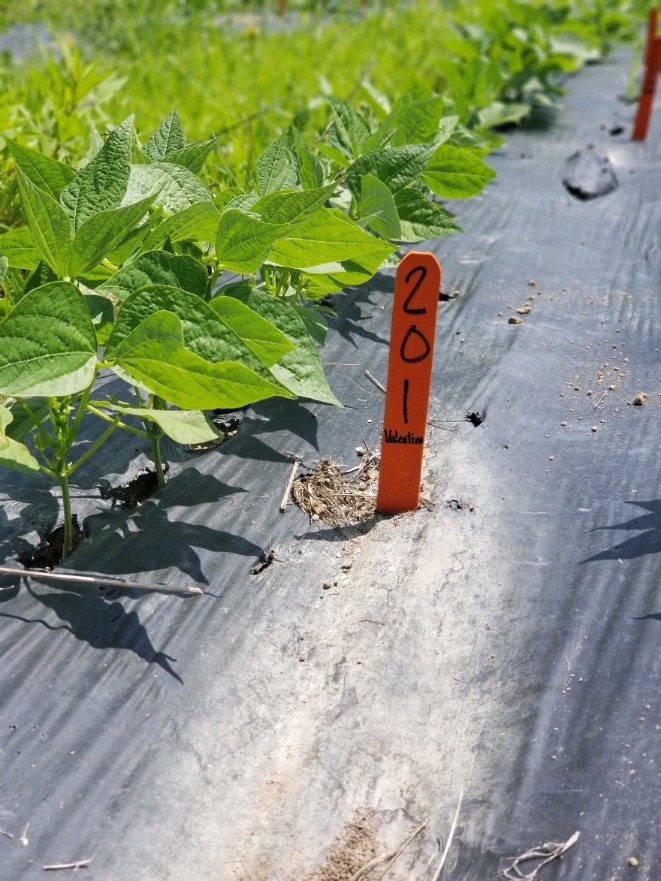
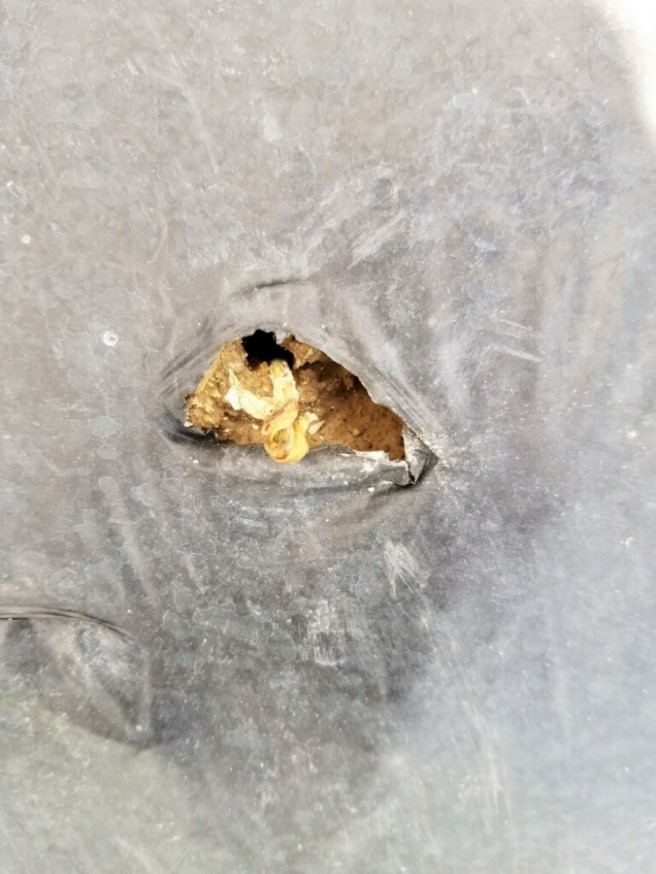
Left: Green bean variety trial set out on last year’s black plastic mulch at Jackson Co Extension office. Right: Direct seeded green bean seedling that burned up when it contacted the hot black plastic mulch. Photos by K. Bell.
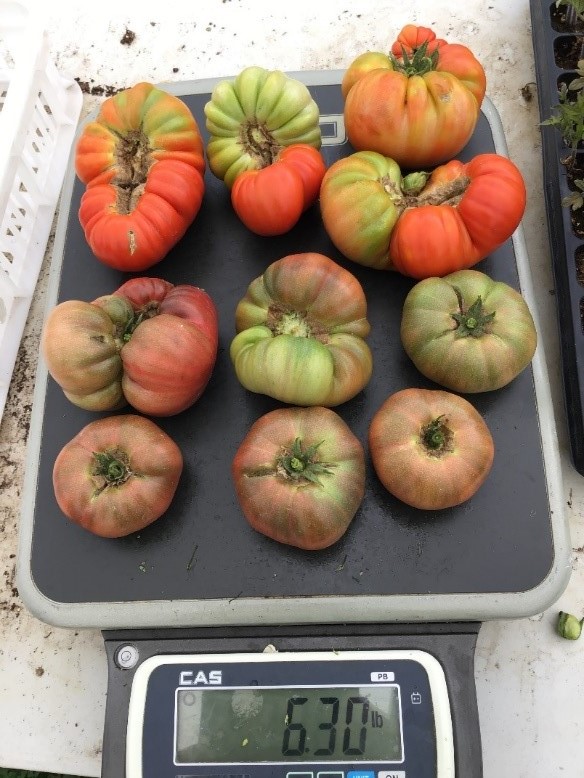
‘Marbonne’ (top red fruit) & ‘Marnouar’ (bottom purple fruit) tomato varieties being grown at Jackson Co. Extension office. Photo by K. Bell.
Katie Bell (618-687-1727; klbell@illinois.edu)
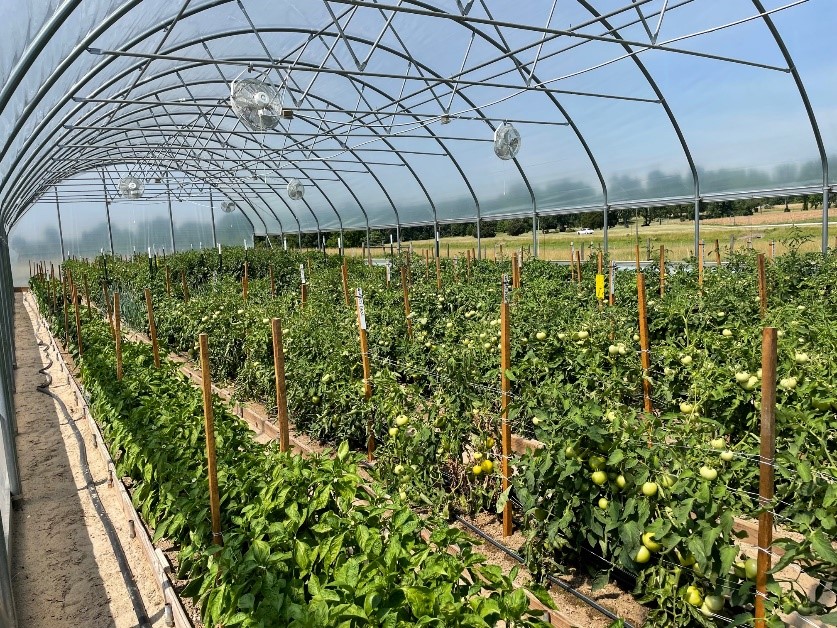
From Dixon Springs Ag Center…As we move through the month of June, it has been pretty typical as far as hot, humid summer days with a few days of cooler, more pleasant temperatures scattered in the mix. The crops are all progressing well in each of the high tunnels, with the hydroponic cucumbers being the most prolific and requiring harvest every other day. Harvest is also continuing on the hydroponic strawberries and cherry tomatoes. The spring crop on the hydroponic raspberries, ‘Double Gold’ and ‘Joan J’, has come to and end and ‘Joan J’ continues to set blooms on new primocanes. The black raspberries are both finished with harvest as well.
Tomato fertility trial plots in high tunnel at DSAC. Peppers are planted in the two outer rows within the tunnel. Yellow sticky traps are scattered throughout the tunnel to monitor the various insects visiting the plants in the tunnel. Photo by B. Aly.
The first harvest on tomatoes in the fertility trial was made on June 10th and the plants appear to be setting a nice fruit load for the remainder of the season. All three varieties, ‘Primo Red’, ‘Red Mountain’, and ‘Mountain Gem’ are sizing well. One observation of the early first fruit from ‘Primo Red’ is the pointed blossom end of the fruit. This can be common with this particular variety and makes it not the best selection for a shipping tomato but the flavor and overall fruit quality make it a fine selection for direct retail sales. We have noted a few tomato plants that are suffering from tomato pith necrosis again this year, but most of the plants are surviving and don’t need to be removed yet. No differences have been observed between fertility treatments from the early harvests but we are expecting to see changes in fruit quality as the harvest season progresses.
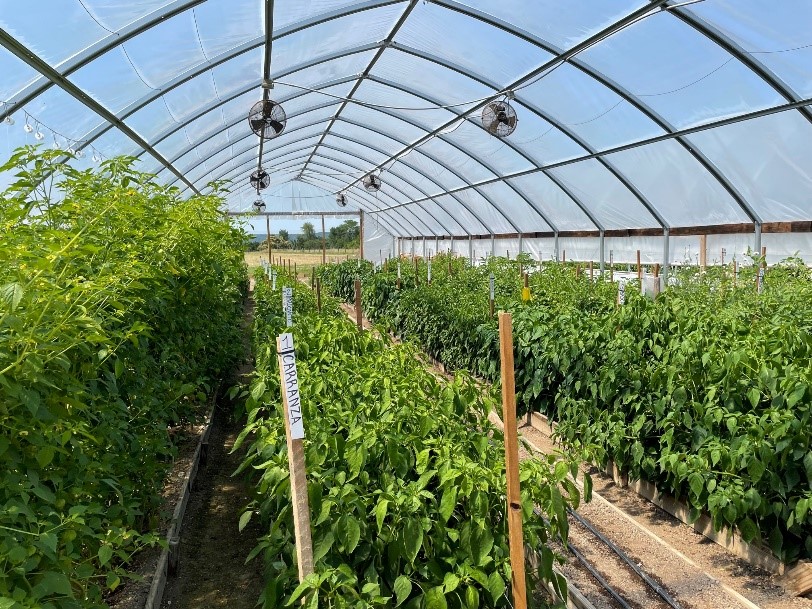
It has been interesting to see the number of different insects visiting the small tomatillo plot compared to the other crops within the same tunnel. We are preparing for the upcoming 2021 Southern Illinois Summer Twilight meeting that will be held at DSAC on June 21st, and the main focus of the twilight meeting will be on high tunnel insect management and the potential for using the biological control strategy of utilizing predator insects to keep pest insects at levels that don’t cause economic damage. We will also discuss the tomato fertilty project as well. The second release of predator insects was released on June 16th , and sticky traps continue to be collected and switched out weekly. These traps allow us to monitor the various insects within each of the high tunnels on our site.
A wide range of crops are planted in this high tunnel at DSAC including tomatillos, peppers, tomatoes, cut flowers, cucumbers, squash, zucchini, carrots, beets, and more. Photo by B. Aly.
Bronwyn Aly (618-382-2662; baly@illinois.edu)
Fruit & Vegetable Production & Pest Management
Renewed Reflex Label on Pumpkins and Winter and Summer Squash and Pumpkin Weed Management Highlights

Herbicide efficacy under heavy waterhemp weed pressure. Approximate, average pricing (for comparison only). Photos: N. Johanning.
Renewed Reflex 24c Label
The renewed 24c label for the use of Reflex herbicide in Illinois on pumpkins has just been renewed as of 6/1/2021. Even if you have previously had the Reflex label you will need to download the renewed label to continue use.
NEW on this label is also the inclusion of winter and summer squash along with pumpkins. This expands the utility and clarifies the use in many of our “specialty pumpkins” many of which are winter squash.
If you are using this product on pumpkins please visit www.syngenta-us.com , click “Crop Protection”, “Indemnified Labels” and log in or create a log in to have access to this label supplement. Then search under “Illinois” and the product(s) you wish to use.
Herbicide Management
In pumpkins we rely predominantly on preemergence (PRE) herbicides especially for broadleaf weed control. Three common PRE herbicides are:
- Strategy
- Sandea (PRE or POST)
- Dual Magnum (row middles or broadcast*)
- Reflex*
*Broadcast use of these product requires signing a waiver and downloading the an indemnified 24c Label which is a supplement to the Federal label (on the jug). See instructions above to access the label.
If waterhemp (pigweeds, etc) are an issue the combination of Reflex and Dual Magnum after planting but before emergence or prior to transplanting is a very effective PRE option. Also, remember there are economical grass herbicides (Select Max or Poast, and generics) that can be sprayed over the top of pumpkins and manage grass weeds. There are very limited postemergence options for broadleaves. Sandea is the only broadcast herbicide that controls any broadleaves. However, its strengths are mainly POST control of cocklebur, nutsedge and has some effectiveness on velevetleaf and smartweed along with others. Generally, it is poor on morningglory and pigweed species. Most pigweeds species have developed resistance to this site of action (ALS) over the last few decades.
Cultural Management
Use of no-till, stale seed beds, and cover crops are all very effective tools in weed management. Remember that everytime you till or work the soil you bring up new weed seeds ready to germinate. Also, if you cultivate between rows where you have a preemergce herbicide applied you will loose almost all of your effectiveness. If you have some weeds that have broke through the PRE this is a fine balance as to how to manage them but just understand this when you approach that decision.
Also make sure that your field is clean of weeds (even small weeds) at planting. Most of the preemergence herbicides do not provide adequate control of emerged weeds so scout your fields up close for any newly emerging weeds especially if it has been more than a week since any tillage or burndown herbicide pass.
Nathan Johanning (618-939-3434; njohann@illinois.edu)
Pumpkin Insect Management
Rick Weinzierl, Extension Entomologist
Revised by Kacie Athey, Specialty Crops Entomologist Department of Crop Sciences, University of Illinois
There are several key pests in pumpkin production. Cucumber beetles, squash vine borers, and squash bugs are perennial pests. Aphids can be important as late summer vectors of virus diseases.
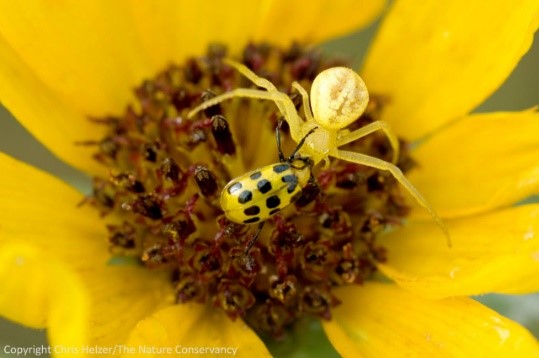
Spider ambushing a spotted cucumber beetle
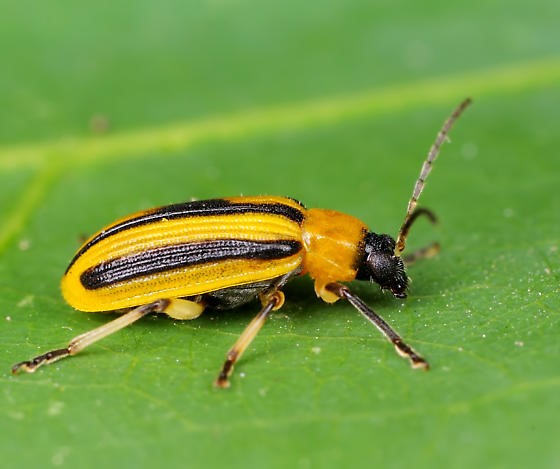
Striped cucumber beetle ©Scott Justis, bugguide.net
Striped and spotted cucumber beetles overwinter as adults and move to crops in the spring and early summer. Two generations develop each year in most of Illinois. For processing pumpkins that are somewhat susceptible to bacterial wilt (caused by a pathogen transmitted by cucumber beetles), the recommended threshold for early season control of cucumber beetles is 1 beetle per plant. Jack-o-lantern pumpkins are not very susceptible to bacterial wilt, so only treat if counts exceed 5 per plant or defoliation is severe. Late in the season, especially on jack-o-lanterns, controlling cucumber beetles may be necessary if they begin to feed on the ripening fruits. This provides an infection pathway for pathogens and makes the fruit less attractive for marketing. Insecticides that control cucumber beetles include planting-time applications of Admire® and foliar applications of Sevin®, Pounce®, or Asana®. Organic growers may use Surround®. If control is necessary when plants are in bloom, growers should make applications when bees are not foraging (early morning or late evening) and use formulations that are less toxic (Surround® or Sevin G®).
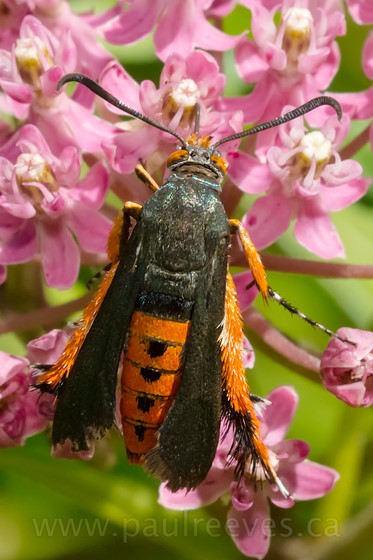
Squash vine borer, bugguide.net
The squash vine borer is the larval stage of a clearwing moth. The body and wings of adult moths are colored with red and black scales, and they resemble wasps. Moths lay eggs at the base of vines, and larvae tunnel within the vines, causing them to wilt. This insect overwinters in the pupal stage, and moths emerge from late May (southern IL) to July (northern IL). In southern Illinois, two generations develop in many years. Control guidelines for squash vine borer call for scouting as soon as vines begin to run, looking for the moths and for entrance holes at the base of vines (from larval tunneling). Treat when first damage is noted and again about a week later.
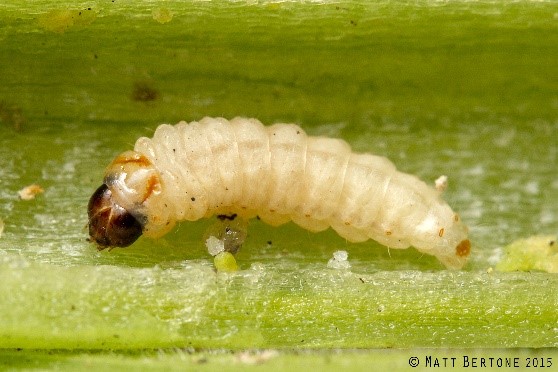
Squash vine borer caterpillar ©Matt Bertone
Several insecticides are effective for vine borer control, including Ambush®, Asana®, Assail®, Brigade®, Mustang Maxx®, Pounce®, and Warrior II®. As with cucumber beetles, organic growers may see some control from applications of Surround®. At the small scale, mounding soil around the base of vines can encourage adventitious root growth from portions of the vine beyond the point of vine borer damage.
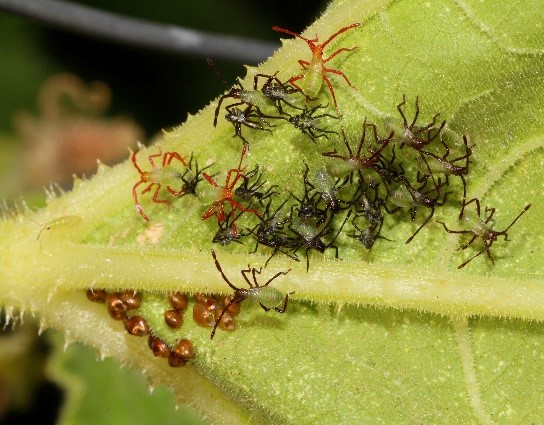
Squash bug eggs and nymphs ©Lon&Queta, flickr.com

The insect most often identified as the scourge of pumpkin production is the squash bug. Squash bugs overwinter as adults and move into pumpkin plantings in June (southern IL) and July (northern IL). In southern Illinois, two generations develop in many years. Adults lay reddish-brown to bronze eggs in small groups on leaves, and those eggs hatch in 7 to 10 days. Immature stages (nymphs) and go through 5 stages that takes 5 to 6 weeks. The key to controlling squash bugs is to detect their presence early and act immediately. Growers are advised to scout for egg masses (clusters), use a threshold of 1 egg mass per plant, and apply insecticides for squash bug control as soon as nymphs hatch and begin feeding. The registered insecticides most effective for squash bug control are Capture® and Brigade®. Other insecticides that provide some control include Asana® and Pounce®, but if growers rely on these insecticides it is imperative that they make applications when nymphs are small as most insecticides are not effective against large nymphs or adults. Natural pyrethrin will give some control for organic growers, but as noted above, application when nymphs are very small is key to any success. Mechanical removal of eggs may be useful for small scale organic growers.
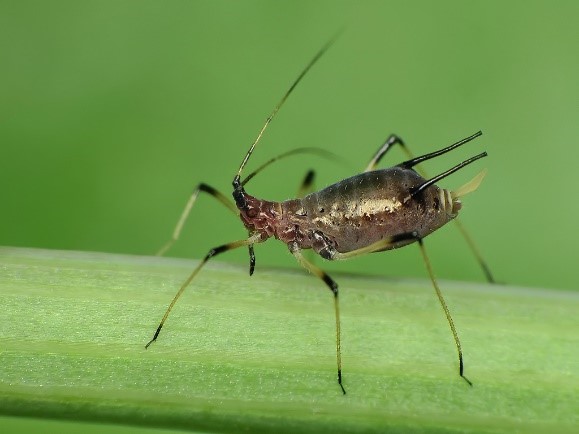
An aphid on a leaf surface, ©Ryszard, flicker.com
Aphids, particularly the cotton-melon aphid, sometimes colonize pumpkins in Illinois. Natural enemy conservation is recommended to control aphids in pumpkin. Parasitoids and predators can be conserved through careful pesticide use or purchased for release. Aphid-borne virus diseases of pumpkins may tempt growers to use insecticides to try prevent such outbreaks. Unfortunately, the major viruses of cucurbits are transmitted in a nonpersistent manner by aphids that pass through vegetable plantings, make a feeding probe or two, and then moving on. Using insecticides to kill aphids within plantings does not prevent introduction of viruses into fields and rarely if ever does much good in the control of viruses transmitted in a nonpersistent manner.
Kacie Athey (217-244-9916; kathey@illinois.edu)
Apple and Peach Insect Management
There are many key pests in apple and peach production. This aticle will feature codling moth, oriental fruit moth, brown marmorated stink bug, woolly apple aphid, dogwood borer, and black stem borer.
*Follow all label instructions for pesticides!
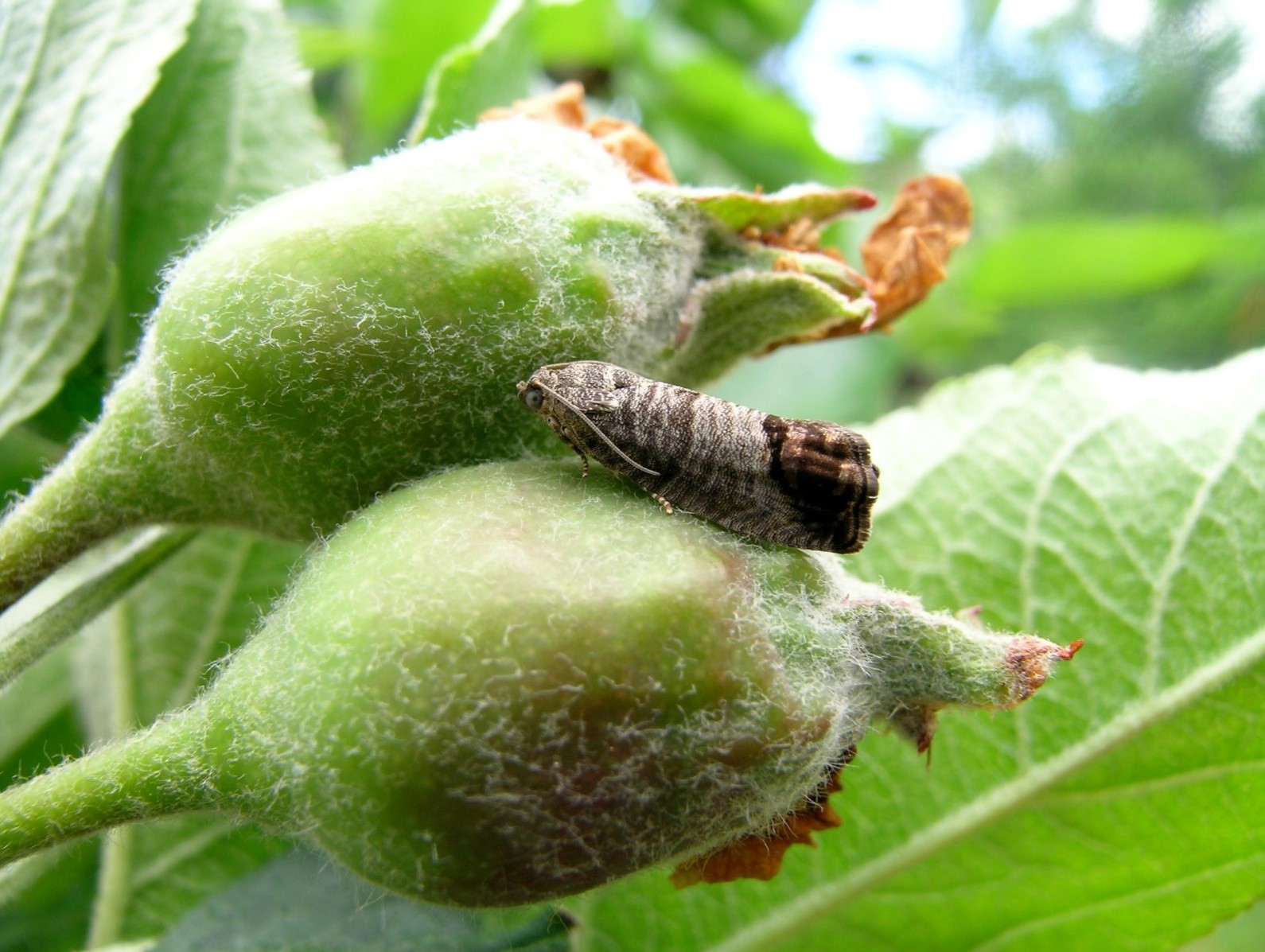
Codling moth © E. Beers
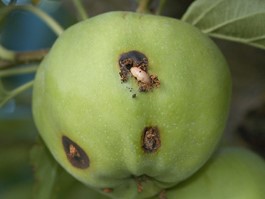
Codling moth damage © E. Beers
Codling moth is a pest in apples and overwinters as a caterpillar and pupates in the spring beginning about bloom with adults emerging in late April or early May. There are two generations per year in Illinois. Once the caterpillar is in the fruit it becomes a cull and the only way to get it out of the field is to remove the infested fruit from the orchard. Sanitation is also very important for codling moth control, fallen fruit should be picked up and destroyed. For monitoring, use pheromone traps hung in the upper third of the canopy with at least one trap every 10 acres. A threshold for insecticide sprays is 5 male moths or 1 female moth per trap per week.
For control, it is very important to target the first generation. The order of use is mating disruption, followed by ovicides and larvicides. Place mating disruption in the upper third of the tree canopy before earliest moth emergence at bloom or 100 degree days with 200-400 per acre. Ovicides, superior oil or horticultural oil, prevent egg hatch by suffocating eggs. Spray at about 375 degree days using a delayed first cover strategy. Larvicides target the newly hatched caterpillars before they enter the fruit and you can use conventional pesticides and/or granulosis virus for organic control. Very precise timing is required and use the delayed first cover strategy by treating at 525 degree days and repeat every 5-7 days.
Insecticides that help control codling moth are Rimon©, Assail©, Esteem©, Intrepid©, Altacor©, Danitol©, or Delegate©. The first generation flight is usually at 1050 degree days and this is biofix for the second generation. At approximately 1300 degree days, the egg hatch for the second generation occurs. First generation treatment of codling moth is essential. Treatment for subsequent generations is not always essential.
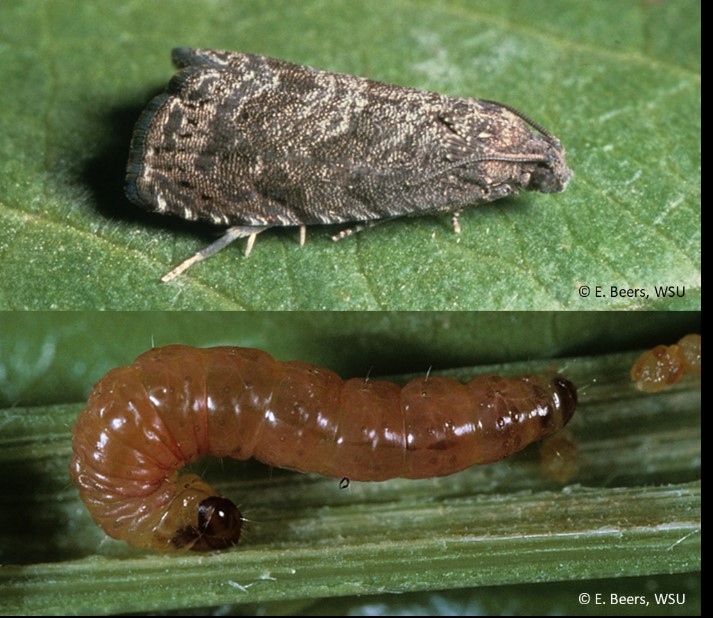
Codling moth damage © E. Beers
Oriental fruit moth (OFM), a pest in both apples and peaches, overwinters as a caterpillar and pupates in the spring in late March with moths emerging at bloom. There can be 6-7 generations a year in Illinois, but the 2nd and 3rd generations are the most damaging. The early season OFM damage succulent terminal growth. In mid-summer OFM attacks fruit with caterpillars boring to the center of the apple often causing fruit dropping to the ground. For monitoring, use pheromone traps hung in the upper third of the canopy with at least one trap every 10 acres. The threshold for spraying is 7 OFM per trap per week. You can use superior oil as on ovicide. Mating disruption for OFM should be placed at pink with 400 twist ties per acre. There are many things labeled for OFM and you want to target peak female flight for sprays.
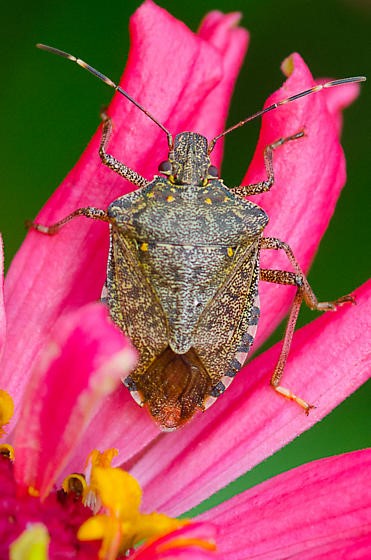
BMSB © Sharon Samford
Brown marmorated stink bug (BMSB), a pest in both apples and peaches, overwinters as an adult in structures. They emerge in April through June and they have one to two generations per year. They lay eggs in rafts on the underside of leaves. Stink bugs directly damage fruit, creating corky, pithy areas from feeding. Attract and kill strategies have had some success in orchards using a pheromone lure to attract BMSB to a few spots in the perimeter of the orchard where insecticides are sprayed. This can reduce the number of insecticide sprays and the amount as you do not need to spray the whole orchard.

BMSB feeding damage © stopbmsb.org
There are quite a few pyrethroids labeled for BMSB (Azera©, Baythroid©, Brigade©, Danitol©, Mustang Maxx©, Warrior II©) and a few neonicotinoids (Actara©, Belay©, Venom©). Always, be careful when using neonicotinoids around bees.

Woolly apple aphid © E. Beers

Woolly apple aphid, a pest in apples, generally overwinters as an egg on elms, but can overwinter as an adult on apple trees. There are several generations per year in Illinois. Woolly apple aphid colonies form at wound sites on trunks, limbs, and twigs and are a serious pest of young apple trees where they feed on tender bark. When the populations get large, the aphids move to the roots where they are difficult to control and can stunt or kill young trees. Root infestations can cause yellowish foliage. To determine if you should spray for woolly apple aphids, examine four pruning scars on each of 5 scaffold limbs per tree and carefully examine the colonies to determine if live aphids are present. The threshold for spraying is when 10% of the pruning scars are infested with live colonies. Diazon©, Closer©, Beleaf©, Movento©, and Admire Pro© are labeled for above ground infestations. There are no insecticides labeled for control of root infestations on bearing apple trees.
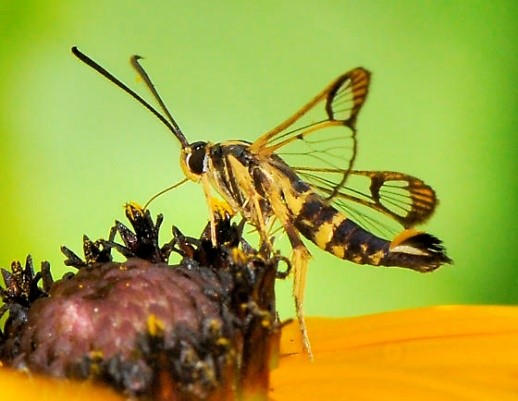
Dogwood borer © Timothy Calkins
Dogwood borer, a pest in apples, overwinters as a larva underneath bark and resumes feeding when temperatures reach above 45 to 50°F. In the spring, larvae pupate, and the pupal stage generally lasts a month and empty pupal cases remain visibly protruding from the bark. Adults lay eggs on bark, preferring injured areas and burr knots. Eggs hatch in 8-9 days and the newly hatched larvae enter bark wounds and form feeding galleries. There is one generation per year with larvae feeding all summer. Dogwood borer larvae cause trunk damage. Early signs to look for are wilting of terminal shoots, sloughing of wood bark, branch and crown dieback. Infested parts of the tree appear swollen and knotty. Leaves may also turn red prematurely

Dogwood borer larvae and damage © James Solomon
For monitoring, pheromone traps are available for dogwood borer. Hang them in the trees in early spring and check it weekly until moth flight begins. Mating disruption is available for dogwood borer and should be hung at bloom, but it can not be purchased in Illinois at the moment. For insecticide sprays, treat at first and second cover, 10-14 days after the first moths are caught. You can apply a second spray if males are still being caught 6 weeks later. Not much is known of the efficacy of the products labeled for dogwood borer. Altacor©, Assail©, Diazinon©, and Lorsban© are all labeled. All except for Altacor© are highly toxic to bees.
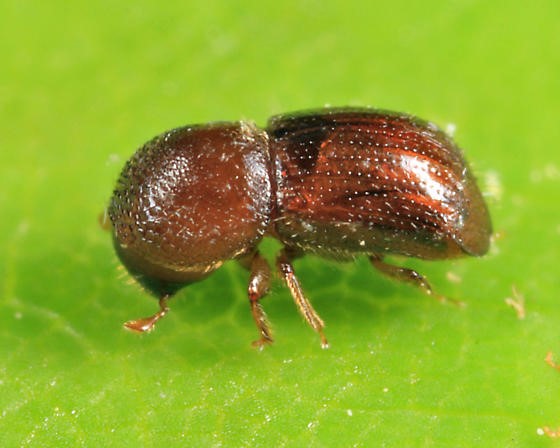
Black stem borer © Tom Murray
Black stem borer, a pest in apples and peaches, overwinters as an adult in galleries or in leaf little near the base of trees. Females emerge in spring to find a new host tree, bore into the sapwood or heartwood where the eggs and larvae develop. The first flight is usually around 75 degree days, between 0.5-inch green and pink in apples and before/during bloom in peaches. Black stem borers cultivate fungal gardens and do not feed directly on the tree, making control difficult. They can have up to 2 generations per year in Illinois. Black stem borers prefer to attack either young or stressed trees.
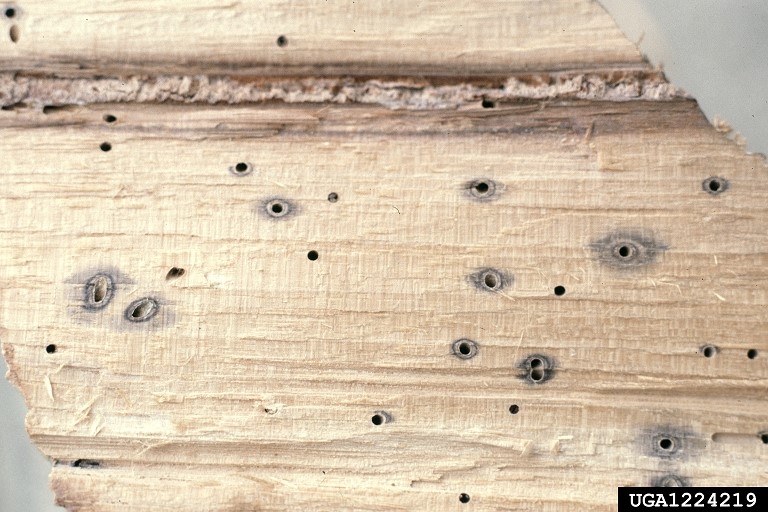
Black stem borer entrance hole © Jerry Payne
Monitoring for black stem borer is done using ethanol traps. Besides using monitoring traps, you can look for signs of infestation including a round entrance hole, one millimeter in diameter often with a string of boring dust or oozing of plant sap. These signs are usually found within 3 feet of the ground. For control, permethrin trunk sprays have shown some efficacy when sprayed at female flight. Later in the season, remove trees with 75% of more of the tree dead or dying and burn it.
Kacie Athey (217-244-9916; kathey@illinois.edu)
Less Seriously
- You start daydreaming about going through the drive-thru and ordering one of every cold drink they sell
- You start saying things like: “well it could always be hotter” or “you know it really isn’t too bad out after all” or “I think I’ll plant another row”
- “Air-Conditioned Office” is a distant and wonderful place that you vaguely remember but can no longer describe
- You devise an elaborate plan to talk the neighbor into letting you swim in their pool
- Water from a garden hose is the best thing you’ve ever tasted
- Broken and leaking irrigation lines are considered an exciting turn of events
- Even the plants look like they don’t want to be outside
- Cleaning your house actually seems enjoyable
- You’re not sure if you are still soaked from fixing the irrigation or if its sweat
- The lagoon starts to look like a good place to go swimming
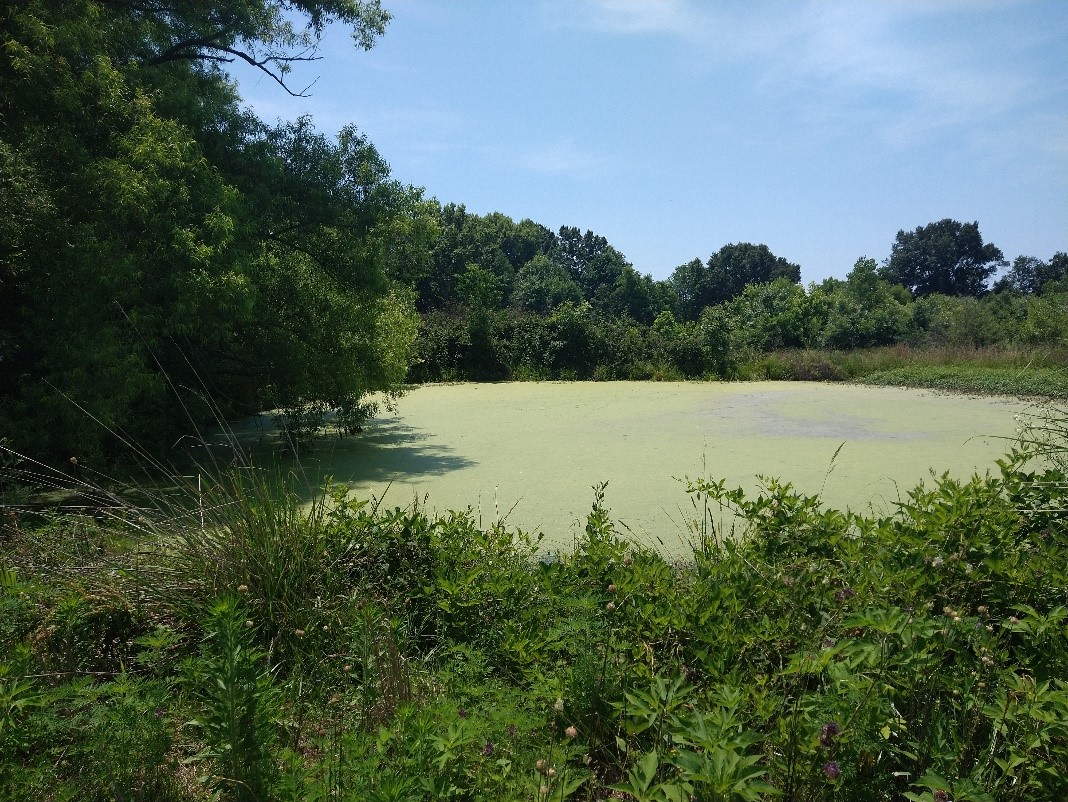
Photo by K. Bell.
University of Illinois Extension Specialists in Fruit and Vegetable Production & Pest Management
Extension Educators – Local Food Systems and Small Farms |
||
Bronwyn Aly, Gallatin, Hamilton, Hardin, Pope, Saline, and White counties |
618-382-2662 |
|
Katie Bell, Franklin, Jackson, Perry, Randolph, & Williamson counties |
618-687-1727 |
|
Sarah Farley, Lake & McHenry counties |
847-223-8627 |
|
Nick Frillman, Woodford, Livingston, & McLean counties |
309-663-8306 |
|
Laurie George, Bond, Clinton, Jefferson, Marion, & Washington counties |
618-548-1446 |
|
Zachary Grant, Cook County | 708-679-6889 | |
Doug Gucker, DeWitt, Macon, and Piatt counties |
217-877-6042 |
|
Erin Harper, Champaign, Ford, Iroquois, and Vermillion counties |
217-333-7672 |
|
Grace Margherio, Jackie Joyner-Kersee Center, St. Clair County |
217-244-3547 |
|
Grant McCarty, Jo Daviess, Stephenson, and Winnebago counties |
815-235-4125 |
|
Katie Parker, Adams, Brown, Hancock, Pike and Schuyler counties |
217-223-8380 |
|
Kathryn Pereira, Cook County |
773-233-2900 |
|
James Theuri, Grundy, Kankakee, and Will counties |
815-933-8337 |
|
Extension Educators – Horticulture |
||
Chris Enroth, Henderson, Knox, McDonough, and Warren counties |
309-837-3939 |
|
Richard Hentschel, DuPage, Kane, and Kendall counties |
630-584-6166 |
|
Andrew Holsinger, Christian, Jersey, Macoupin, & Montgomery counties |
217-532-3941 |
|
Extension Educators - Commercial Agriculture |
||
Elizabeth Wahle, Fruit & Vegetable Production |
618-344-4230 |
|
Nathan Johanning, Madison, Monroe & St. Clair counties |
618-939-3434 |
|
Campus-based Extension Specialists |
||
Kacie Athey, Entomology |
217-244-9916 |
|
Mohammad Babadoost, Plant Pathology |
217-333-1523 |
|